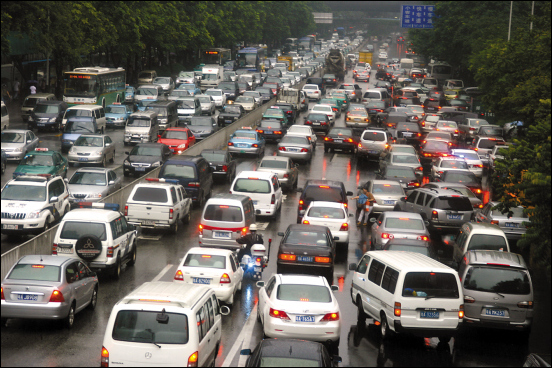
With the sustained rapid economic and social development progress of Guangzhou, and the consequential significant rise of disposable income of its expanding population, there has been continuous increase of automobile purchases and car ownership, resulting in an escalating trend of traffic congestion in the central city area. According to official statistics, from August 15, 2007 when Guangzhou’s car ownership passed the one-millionth mark, this number had exceeded 2.5 million by 2013, an increase of 1.5 times over 6 years [1]. Five years prior to the policy limiting automobile registration, Guangzhou’s car ownership level was already at 90 vehicles per 1000 population with an annual growth rate of 22.1% [2], Although the vehicle registration limitation has helped in slowing the excessive growth of new private cars, the huge car ownership situation in Guangzhou continues to impose enormous traffic pressure on the roads. (A 2015’s national survey of car ownership in major cities found Guangzhou’s car ownership to be 2.695 million, ranked 6th amongst major cities nationwide [15].) Guangzhou city is thus in urgent need of outward expansion to relieve excessive agglomeration of population and traffic in the city center. Since 2009, under the combined effects of various factors, average evening peak hours’ car traffic speed has dropped to 18.7km/h along the main downtown roads of Guangzhou [2]. Despite significant expansion of MRT systems with their effective service of public travel, traffic congestion had by 2013 extended to most parts of the central city areas, with road saturation rate reaching 0.9 on average for the main roads. It is already a norm for morning and evening peak hours’ traffic in Guangzhou’s downtown roads to drop to an average speed of 20km/h or less on work days [3]. Guangzhou traffic situation data released in the “Guangzhou Transportation Development White Paper” of October 2013 showed the root cause of congestion in downtown Guangzhou as the limited vehicle carrying capacity of the roads. The daily carrying capacity within the 10 districts of Guangzhou Municipality can only accommodate 1.65 million vehicle-trips, while that for the central city area is at an even lower level of one million vehicle-trips [1]. Increasing competition for limited road transportation resources has thus inevitably resulted in Guangzhou City’s road traffic congestion.
The 2010 Census found the following data of pertinence on the severity of Guangzhou’s traffic congestion: the four central districts of Yuexiu, Liwan, Haizhu and Tianhe within the older Guangzhou township area have an average population density of 27,531 people/km2. In particular, Yuexiu District has a population density 52,834 people/ km2 [16], putting it 4th highest amongst the world’s urban areas. (For comparison, the top three ranking areas are: Shanghai Hongkou District at 36306, Manhattan of New York City at 26653, and Zone 1 of London at 27100 people/km2 [17]). It is conceivable that over the five years since the 2010 Census, there has been further intensification of population in these central districts due to Guangzhou’s continuing growth, with the city-ward population shifts facilitated by the completion and running of more high-speed rails and MRT networks into Guangzhou. In order to promote the travel and migration of the central zones’ residents to the periphery areas, the development of high efficiency advanced transportation linkages between the city center and the outskirt areas is becoming a pressing necessity. Meanwhile, in the eastern zone, the enlarged Huangpu District after its 2015 merger with the Luogang District now covers an area of 484 km2 with a relative sparse population of 880,000 [18], which is only 1818 people/km2. The contrast depicts clearly that, while the over-concentration of population in the central city is bringing about tremendous pressure on the community and constraining the municipality’s public transportation resources, the situation can be relieved by appropriate “Eastern Expansion” with the needed connectivity measures in place. Hence it can be expected that such an “Eastern Expansion” is an inevitable physical aspect of Guangzhou’s economic growth and development strategy. To facilitate the associated population distribution and their travel needs, a priority focus should be the study and implementation of public transport facility upgrades including but not limited to road system optimization and subway MRT extensions. This unique challenge poses an opportunity for the pioneering development of a state-of-the-art public transport modality that can effectually enable the “Eastern Expansion” while relieving the over-intensification of population in the city cente. Otherwise, mere building of more roads and further restriction of vehicle registration will not help in easing road congestion in the city center. In this regard, it is interesting to note the “Proposals on the Construction of Guangzhou City Bus” [5], issued in August 2013 by the Guangzhou Development Research Institute, which reported that Guangzhou’s public transport system carried a daily traffic of about 14.48 million passengers, accounting for 60% of motorized travel. This is similar to the figure of 59.6% stated in the “2010 Guangzhou Transport Development Annual Report”. While it is thus evident that public transport is the main mode of travel in Guangzhou (stabilizing at about 60% over the recent years), this is still a wide gap from those of Tokyo and Hong Kong (at 82% to 87%).
With the two-prong objectives of easing population concentration and relieving traffic congestion, it is opportune for Guangzhou to actively implement the “public transportation priority” development strategy. This should encompass measures to enhance transportation infrastructure, optimize traffic travel management, emphasize smart transportation development, upgrade transportation service level and operational efficiency, and build long-term working mechanism that can progressively ease traffic congestion effectively. Taking the perspective of low-carbon and ecological city development, combined with reference to latest international know how and trends of public transportation development, it is recommended to research and build a sustainable smart (automation-guided) transport system that will serve as one of the significant public transportation modalities of Guangzhou, supplementing the subway MRT networks that will undoubtedly still be of increasing importance as the primary public transport system.
。
